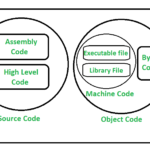Introduction
At the heart of every computer’s operation lies machine language, the elemental code that communicates directly with the hardware. Machine language is the most fundamental form of programming, consisting of binary instructions that computers can execute without any translation. In this blog, we’ll delve into the intricate world of machine language, uncovering its importance, applications, and its role in shaping the digital landscape.
- Decoding Machine Language
Machine language, also known as machine code, is the language understood by computers at the lowest level. It consists of sequences of binary digits (0s and 1s) that correspond to specific instructions for the computer’s central processing unit (CPU).
- Direct Interaction with Hardware
Unlike high-level programming languages that require translation into machine code, machine language instructions are executed directly by the CPU. This direct interaction with hardware makes machine language the most efficient and powerful form of programming.
- Hardware-Dependent Instructions
Machine language is highly dependent on the computer’s architecture. Each type of CPU has its own unique set of machine instructions, making machine language programs specific to a particular hardware platform.
- Assembly Language vs. Machine Language
Assembly language serves as a human-readable representation of machine code. While assembly language uses mnemonic symbols to represent instructions, machine language is composed of raw binary code that CPUs can directly interpret.
- Embedded Systems and Real-time Applications
Machine language is often used in embedded systems, where hardware resources are limited, and performance is crucial. Real-time applications like robotics, automation, and control systems require precise and fast execution, making machine language an ideal choice.
- Operating System Kernels
Operating system kernels, the core components that manage system resources, are often written in machine language or a combination of assembly and machine language. This ensures efficient interaction with hardware.
- Low-Level Debugging
Machine language allows for low-level debugging, enabling programmers to analyze and troubleshoot issues directly within the hardware. This level of visibility is invaluable for diagnosing complex problems.
- Bootstrapping Process
During the bootstrapping process, the computer’s firmware loads the initial boot loader, which is often written in machine language. This minimal code initializes the system and prepares it for loading the operating system.
- Fundamental Understanding of Computing
Studying machine language provides a deep understanding of how computers operate at the lowest level. It unveils the binary foundation upon which all software is built, enhancing the programmer’s appreciation for the digital world.
- Legacy and Future of Computing
Machine language is the foundation of modern computing. While high-level languages offer convenience, machine language remains essential for system-level programming, ensuring the seamless interaction between software and hardware.
Conclusion
Machine language forms the bedrock upon which the digital world is constructed. Its direct communication with hardware, unparalleled efficiency, and role in shaping computing history make it an indispensable tool. Whether you’re an embedded systems developer, a low-level programmer, or simply seeking to deepen your understanding of computers, exploring machine language opens doors to a profound realm where 0s and 1s converge to create the intricate dance of digital life.




